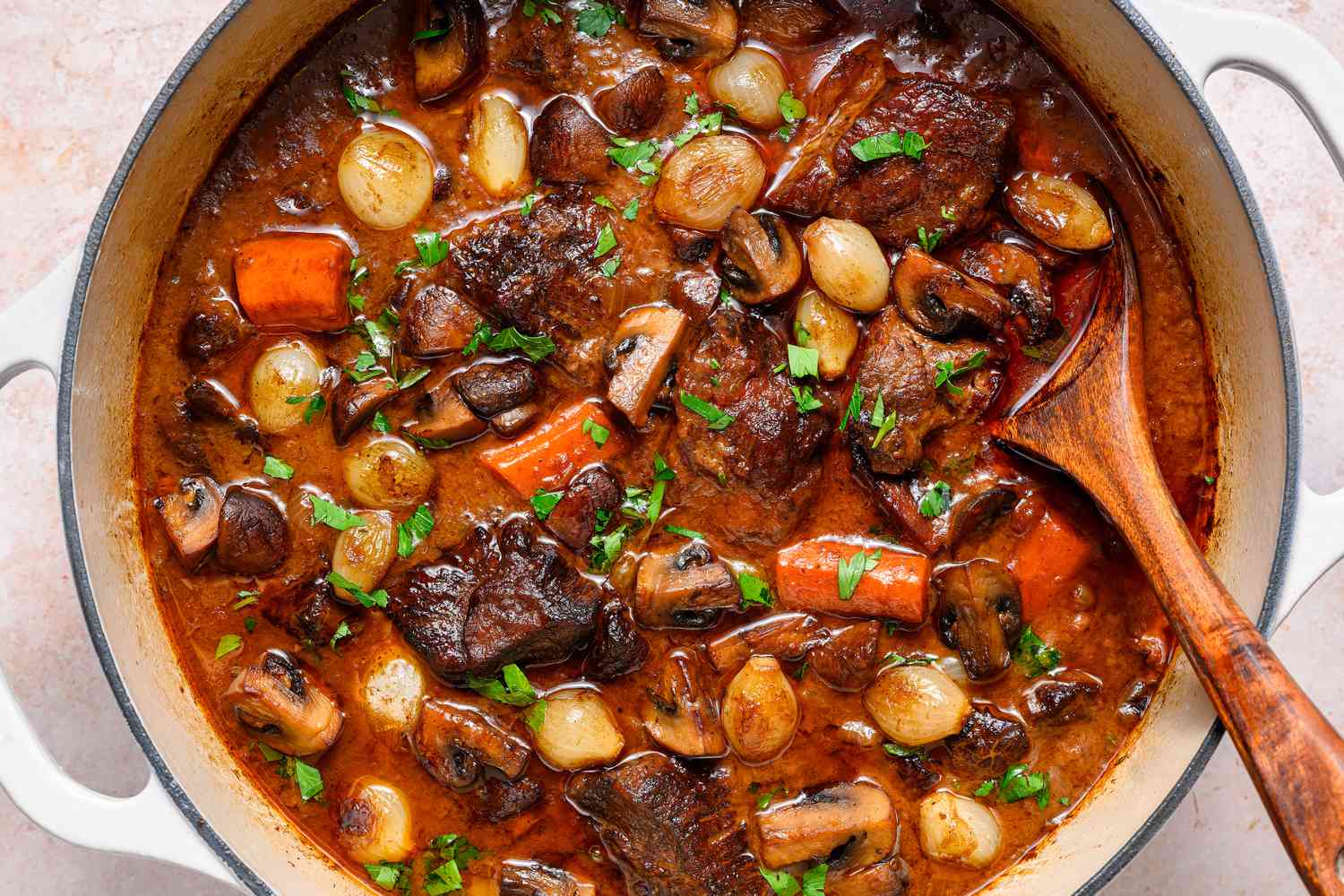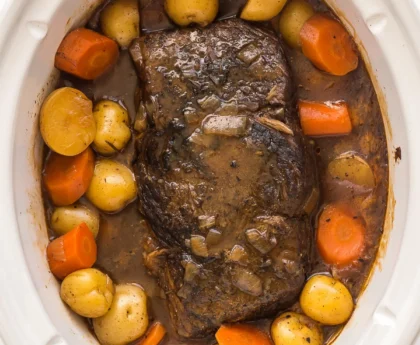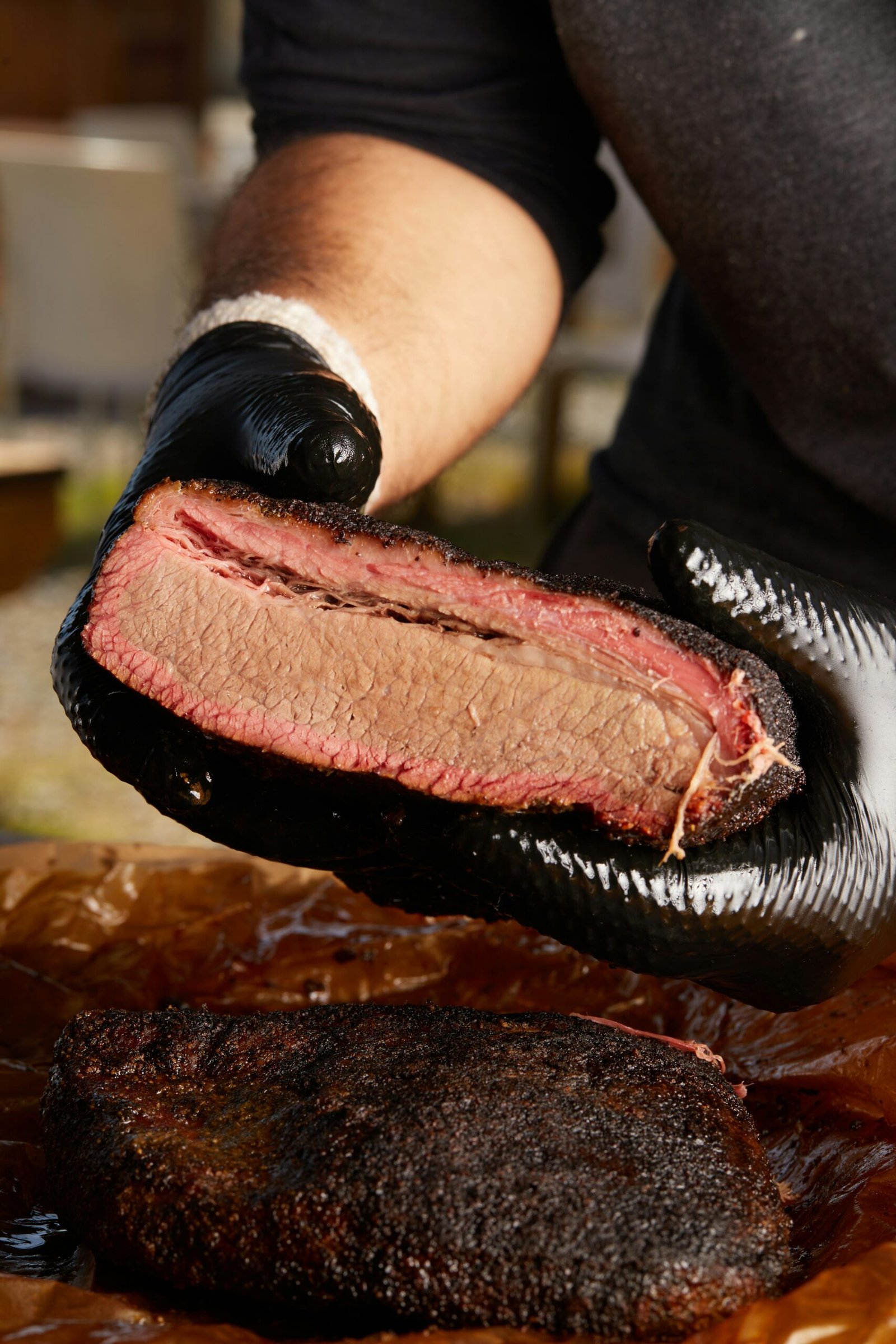
Introduction to Beef Bourguignon
Beef Bourguignon, a quintessential dish of French cuisine, traces its origins back to the Burgundy region, known for its exceptional wines and culinary traditions. This hearty stew, traditionally made with beef braised in red wine, has earned its place as a beloved comfort food for generations. Its enduring popularity can be attributed to the rich, complex flavors that develop through a meticulous slow-cooking process.
Historically, Beef Bourguignon was a peasant dish, utilizing affordable cuts of beef that benefit from long, slow cooking to become tender and flavorful. Over time, it has evolved into a celebrated classic, often featured in upscale dining establishments and cherished in home kitchens alike.
The key components of Beef Bourguignon are simple yet integral to its depth of flavor. Tender chunks of beef are the star, ideally sourced from quality cuts such as chuck or brisket, which stand up well to prolonged cooking. Red wine, preferably a robust Burgundy, infuses the meat with a rich, savory taste, while a medley of aromatic vegetables—such as onions, carrots, and garlic—complements the dish with their natural sweetness and earthiness.
Quality ingredients are paramount in mastering Beef Bourguignon. Opt for fresh, seasonal vegetables and a good-quality red wine to ensure the best results. The slow-cooking process is equally critical; it allows the flavors to meld and intensify, creating a dish that is both deeply satisfying and complex.
In essence, Beef Bourguignon is more than just a stew; it is a testament to the art of French cooking, where patience and attention to detail transform simple ingredients into a culinary masterpiece. Whether served at a family gathering or a formal dinner, this dish continues to captivate and comfort, making it a timeless favorite.
Gathering Ingredients and Essential Tools
Preparing a delectable Beef Bourguignon requires a meticulous selection of fresh, high-quality ingredients and essential kitchen tools. Start with the star of the dish: the beef. Opt for cuts like chuck or brisket, which are ideal due to their rich marbling and ability to become tender after slow cooking. These cuts can typically be found at your local butcher or high-end grocery stores.
Equally important is choosing the right red wine, as it serves as the backbone of the recipe. A full-bodied red wine such as Burgundy, Pinot Noir, or a Cabernet Sauvignon will infuse the dish with robust flavors. The wine should be of good quality, as its complexity enhances the overall taste. Avoid using cooking wines; instead, select a bottle you would enjoy drinking.
For the vegetables, you’ll need carrots, onions, and mushrooms. Carrots add a hint of sweetness, while onions provide depth, and mushrooms contribute an earthy undertone. Optional ingredients like bacon or pearl onions can elevate the dish, adding layers of flavor and texture. Bacon brings a smoky richness, and pearl onions add a subtle sweetness and visual appeal.
Stocking up on fresh herbs such as thyme, bay leaves, and parsley is essential for seasoning. Additionally, garlic cloves, tomato paste, and beef broth are crucial components that round out the flavor profile of the dish.
Essential tools for preparing Beef Bourguignon include a sturdy Dutch oven, which is perfect for slow-cooking and retaining heat evenly. Sharp knives are indispensable for precise chopping and slicing, and a reliable cutting board ensures a stable surface. A slotted spoon is useful for removing ingredients without excess liquid, and a ladle helps with serving.
When sourcing these ingredients, consider shopping at farmers’ markets or specialty food stores to ensure the highest quality. Fresh, organic produce and premium cuts of meat will make a noticeable difference in the final dish, turning your Beef Bourguignon into a culinary masterpiece.
Step-by-Step Cooking Instructions
Preparing a classic Beef Bourguignon with red wine requires meticulous attention to detail and a patient cooking process. Begin by preparing the beef. Choose a high-quality cut of beef chuck, cut into 2-inch cubes. Marinate the beef in red wine, preferably a Burgundy, for at least 4 hours or overnight in the refrigerator. This step infuses the meat with rich, robust flavors and tenderizes it.
Once marinated, remove the beef from the wine and pat it dry with paper towels. Reserve the wine for later use. Season the beef cubes with salt and pepper. Heat a large, heavy-bottomed pot or Dutch oven over medium-high heat and add a few tablespoons of olive oil. Sear the beef in batches until all sides are browned, ensuring not to overcrowd the pot. This searing step is crucial as it locks in the juices and enhances the flavor profile of the dish.
After searing the beef, set it aside and lower the heat to medium. In the same pot, add diced carrots, onions, and garlic. Sauté the vegetables until they are softened and slightly caramelized, about 5-7 minutes. This builds a flavorful base for the stew. Next, sprinkle a couple of tablespoons of flour over the vegetables and stir well, cooking for another 2 minutes to eliminate the raw flour taste.
Deglaze the pan with the reserved red wine, scraping up the browned bits from the bottom of the pot. This step adds depth and complexity to the sauce. Return the beef to the pot and add beef broth, tomato paste, and a bouquet garni (a bundle of herbs such as thyme, bay leaves, and parsley). Bring the mixture to a gentle boil, then reduce the heat to low and simmer, partially covered, for 2 to 3 hours. Alternatively, you can transfer the pot to a preheated oven at 325°F (163°C) and cook for the same duration.
During the last hour of simmering, add pearl onions and mushrooms to the pot. These ingredients will absorb the flavors of the stew without becoming overly soft. Stir occasionally and check the seasoning, adjusting salt and pepper as needed. The final consistency of the sauce should be thick and glossy, coating the back of a spoon. If the sauce is too thin, simmer uncovered for the last 30 minutes to reduce it.
To achieve the perfect flavor balance, ensure that the beef is tender and the vegetables are cooked through. Serve your Beef Bourguignon with crusty bread or over mashed potatoes to soak up the delicious sauce. Enjoy this classic French dish, knowing that you have mastered the art of creating a rich, hearty stew infused with the depth of red wine flavors.
Serving Suggestions and Pairings
Beef Bourguignon, steeped in rich flavors from red wine and tender beef, deserves accompaniments that amplify its depth without overshadowing its essence. A traditional way to serve this sumptuous dish is alongside crusty French bread. The bread not only complements the robust sauce but also serves as an excellent tool for sopping up every last bit of the savory broth.
Another classic pairing is creamy mashed potatoes. Their smooth texture and subtle flavor profile provide a perfect counterbalance to the hearty stew. For those who prefer pasta, buttered noodles are an equally delightful option. Their simplicity allows the complex flavors of the Beef Bourguignon to shine through.
When considering side dishes, think of elements that can add a touch of freshness and variety. A crisp green salad with a light vinaigrette can offer a refreshing contrast, cleansing the palate between bites. Fresh herbs like parsley or thyme can be used as garnishes, adding a pop of color and an extra layer of aromatic complexity.
Wine pairings play an integral role in enhancing the dining experience. Given the dish’s rich and savory profile, it’s best to opt for robust red wines such as Pinot Noir or a bold Bordeaux. These wines share flavor notes with the ingredients in the dish, creating a harmonious blend that elevates the overall taste.
For those interested in storing leftovers, it’s essential to let the dish cool completely before refrigerating. Beef Bourguignon often tastes even better the next day as the flavors continue to meld. When reheating, do so gently on the stovetop to maintain the integrity of the meat and sauce. Avoid using a microwave, as it can alter the texture and flavor.
By following these serving suggestions and pairings, you can ensure that your Beef Bourguignon experience is as delightful and memorable as the dish itself.



